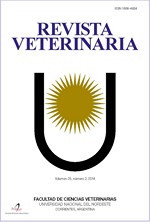Occupational risks in veterinary students in Argentina
DOI:
https://doi.org/10.30972/vet.3013914Keywords:
Students, veterinary, occupational health, exposure, risksAbstract
Veterinary practice exposes individuals to a wide variety of occupational accidents (OA) and occupational diseases. The objectives of this work were to estimate: a) the frequency of OA and zoonoses, b) the perception of occupational risks (RP), c) the use of personal protective equipment (PPE) and d) the association with potential risk factors in veterinary students of Argentina. A cross-sectional observational study was carried out in n=778 students of 13 veterinary careers located in nine Argentine provinces. The data were collected through a structured self-administered questionnaire. Statistical analysis included χ2, Student’s t test and Pearson’s and Spearman’s correlations. Two thirds (67.5%) had suffered OA in large and small animal practice, with great variability among universities (p=0.002). The most frequent accidents were linked to excessive sun exposure, animals and sharp instruments. Although clinical examinations were perceived as medium or low risk activities, OA occurred mostly in these instances. Lesions were located mostly in the upper limbs. Six percent of students had been diagnosed with a zoonosis, being dermatophytosis (2.8%) the most frequent. The higher the number of years as a veterinary student, the higher the RP (p<0.005) and the frequency of OA (p<0.034). Gloves were the most used PPE. In some practices, women used PPE more frequently than men (p<0.03). There were no associations between the frequency of use of PPE and RP or number of years as a veterinary student. It is concluded that occupational safety practices should be offered from the first years of the career. This practice, along with teachers’ efforts to enforce students’ observation of safety practices could modify attitudes, reducing the risks of OA and zoonoses among students.
Downloads
Downloads
Published
How to Cite
Issue
Section
License
Copyright (c) 2019 H D. Tarabla, A I. Molineri, H Robin, M L. Signorini

This work is licensed under a Creative Commons Attribution-NonCommercial 4.0 International License.
Revista Veterinaria (Rev. Vet.) maintains a commitment to the policies of Open Access to scientific information, as it considers that both scientific publications as well as research investigations funded by public resources should circulate freely without restrictions. Revista Veterinaria (Rev. Vet.) ratifies the Open Access model in which scientific publications are made freely available at no cost online.










.jpg)
.jpg)



